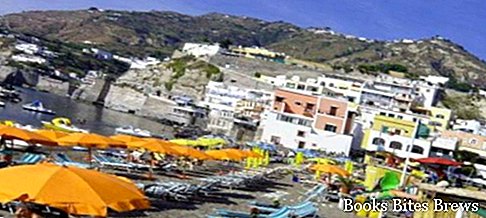What to see in Ischia, itinerary including the main monuments and places of interest, including Aragonese Castle, Lacco Ameno and Villa La Colombaia.
Tourist information
Located in the Tyrrhenian Sea, in the northern part of the Gulf of Naples near the islands of Procida and Vivara, the island of Ischia is of volcanic origin and reaches its maximum altitude in the central part with Mount Epomeo, whose top reaches 787 meters .
Mount Epomeo, consisting of tufaceous rock, the famous green tuff of Ischia, is not a volcano, but its formation is due to the lifting of the earth's crust during one of the many volcanic activities that occurred in ancient times.
The volcanic nature of Ischia is manifested by an intense hydrothermal activity, exploited since ancient times for therapeutic purposes and still highly appreciated by the many tourists who visit the island.
Ischia was inhabited since the Neolithic period, as evidenced by the various finds found in some areas of the island.
The first visitors were the Phoenicians, the Greeks founded their first colony here and introduced the processing of clay, fueling a flourishing trade with the peoples of the Mediterranean coast, later the island passed under the dominion of Naples and remained there until it was conquered by the Romans.
Subsequently, Emperor Augustus returned it to Naples in exchange for Capri, making it a popular holiday resort for the Romans.
At the end of the fourth century, with the collapse of the Roman Empire, barbarian invasions and Byzantine rule followed.
In the ninth century the Saracen invasions began.
In the twelfth century the island was occupied by the Normans, followed by Swabians and Angevins.
From the fifteenth to the eighteenth century it was the Aragonese who dominated the island, until the Kingdom of Naples and the arrival of the Bourbons, finally in the nineteenth century the annexation to the Kingdom of Italy took place.
Recommended readings- Sapri (Campania): what to see
- Campania: Sunday day trips
- Amalfi (Campania): what to see
- Acciaroli (Campania): what to see
- Teano (Campania): what to see
What see
The Aragonese Castle, whose history tells the story of Ischia, is a fortification located on a rocky islet connected by a masonry bridge to the ancient seaside village, called Ischia Ponte or the village of Celsa.
Of the first building, dating back to 474 BC, nothing is left, the current structure is from 1441.
The Castle, built by Alfonso D'Aragona, included various types of accommodation and served as a refuge during pirate raids.
In the sixteenth century, a period of great splendor, it hosted numerous families, the Abbey of the Basilian Monks of Greece, the Convent of the Poor Clares, the Bishop with the Chapter and the seminary, the Prince with the garrison and thirteen churches.
In 1700 it was abandoned and in 1809 almost destroyed by the British.
In 1851, when the Bourbons reigned, it became a political prison until 1861, the year in which Ischia was annexed to the Kingdom of Italy.
In Lacco Ameno, an ancient village famous for its characteristic mushroom-shaped tuff rock, which has become a city symbol, the Church of Santa Restituita, the Museum of Santa Restituita and the Museum of Villa Arbusto are worth a visit.
The Church of Santa Restituita, patron saint of the island, has undergone various renovations over the centuries.
The first early Christian basilica was built between the fourth and fifth centuries AD, in an area where there was a Roman cisternone.
The current structure dates back to 1500 and the neoclassical facade is from 1910.
In the Museum of Santa Restituita there are archaeological finds from various eras, which testify to the life and culture of Ischia in the time of the Greeks and early Christians.
Villa Arbusto, located on a hill in a privileged panoramic position, houses a museum that collects interesting archaeological finds.
Near the center of Lacco Ameno, in the Bay of San Montano, there is a beautiful beach where the descent into the water is gradual, in fact you can touch your feet up to about 40 meters from the shoreline.
On this beach, coming from the African shores, the body of Santa Restituita landed, whose feast is celebrated on May 17th of each year.
In the bay of San Montano there is one of the main thermal parks on the island.
The village of Forio has as its symbols the Church of Soccorso, situated overhanging the sea, and the Torrione.
On the promontory of Zaro, overlooking Forio, there is Villa La Colombaia, the historic summer residence of Luchino Visconti.
Having become a public heritage, the Villa now houses the Foundation and Museum dedicated to the director, as well as the International School of Cinema and Theater.
At Villa La Mortella, William Walton lived, one of the greatest contemporary English composers.
This residence, used as a study center for talented young musicians, is surrounded by a magnificent garden, open to the public together with the House Museum.
In addition to the cultural aspect, Forio offers an interesting and very particular nature, such as the Bay of Sorgeto, where the thermal water flows from the shore, and the Bay of Citara, where the large Poseidon Gardens Natural Park extends, with numerous swimming pools that they exploit the thermal springs on the beach.
From the port of the characteristic village of Sant'Angelo it is possible to go on boat tours, which allow you to admire the beautiful coastal landscape.
To enjoy an extraordinary panorama, an excursion to Mount Epomeo is recommended.




